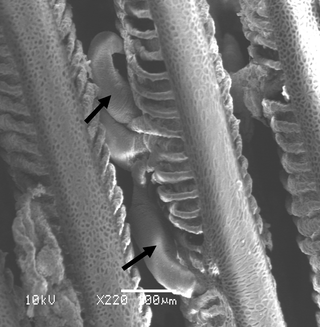
Pseudorhabdosynochus is a genus of monopisthocotylean monogeneans, included in the family Diplectanidae. The type-species of the genus is Pseudorhabdosynochus epinepheli .

Pseudorhabdosynochus epinepheli is a diplectanid monogenean parasitic on the gills of species of groupers. It is the type species of the genus Pseudorhabdosynochus Yamaguti, 1958.

Pseudorhabdosynochus capurroi is a diplectanid monogenean parasitic on the gills of the Black grouper, Mycteroperca bonaci. It was described by Vidal-Martínez and Mendoza-Franco in 1998 and redescribed successively by Yang, Gibson and Zeng in 2005 and by Kritsky, Bakenhaster and Adams in 2015.
Pseudorhabdosynochus auitoe is a diplectanid monogenean parasitic on the gills of the Highfin grouper, Epinephelus maculatus. It was described in 2007.
Pseudorhabdosynochus fuitoe is a diplectanid monogenean parasitic on the gills of the highfin grouper, Epinephelus maculatus. It has been described in 2007.
Pseudorhabdosynochus guitoe is a diplectanid monogenean parasitic on the gills of the Highfin grouper, Epinephelus maculatus. It has been described in 2007.
Pseudorhabdosynochus amplidiscatus is a diplectanid monogenean parasitic on the gills of groupers. It was described as Diplectanum amplidiscatum by Bravo-Hollis in 1954 and transferred to the genus Pseudorhabdosynochus by Kritsky and Beverley-Burton in 1986.
Pseudorhabdosynochus justinei is a species of diplectanid monogenean that is parasitic on the gills of the longfin grouper Epinephelus quoyanus. It was described in 2007 by Binjian Zeng and Tingbao Yang from material from the South China Sea, and redescribed in 2009 by Justine, Dupoux & Cribb from material from off Queensland, Australia.
Pseudorhabdosynochus chauveti is a species of diplectanid monogenean that is parasitic on the gills of the blue grouper Epinephelus cyanopodus. It was described in 2008.
Pseudorhabdosynochus cyanopodus is a species of diplectanid monogenean that is parasitic on the gills of the blue grouper Epinephelus cyanopodus. It was described in 2008.
Pseudorhabdosynochus podocyanus is a species of diplectanid monogenean that is parasitic on the gills of the blue grouper Epinephelus cyanopodus. It was described in 2008.
Pseudorhabdosynochus exoticoides is a species of diplectanid monogenean that is parasitic on the gills of the brownspotted grouper Epinephelus chlorostigma. It was described in 2010.
Pseudorhabdosynochus exoticus is a species of diplectanid monogenean that is parasitic on the gills of the blue grouper Epinephelus cyanopodus. It was described in 2008.
Pseudorhabdosynochus chinensis is a species of diplectanid monogenean parasitic on the gills of the greasy grouper, Epinephelus tauvina. It was described in 2001.

Pseudorhabdosynochus lantauensis is a diplectanid monogenean parasitic on the gills of the longtooth grouper, Epinephelus bruneus. It was described in 1981 as Cycloplectanum lantauensis and later transferred to the genus Pseudorhabdosynochus by Kritsky & Beverley-Burton in 1986.
Pseudorhabdosynochus serrani is a species of diplectanid monogenean parasitic on the gills of a fish. It was described in 1953 by Satyu Yamaguti as Diplectanum serrani and later transferred to the genus Pseudorhabdosynochus. The species has been redescribed in 2005.
Pseudorhabdosynochus shenzhenensis is a species of diplectanid monogenean parasitic on the gills of the grouper Epinephelus coioides. It was described in 2005.
Pseudorhabdosynochus summanoides is a species of diplectanid monogenean parasitic on the gills of the orange-spotted grouper Epinephelus coioides. It was described in 2005.
Pseudorhabdosynochus vagampullum is a species of diplectanid monogenean parasitic on the gills of a grouper. It was described in 1969, from eight specimens, under the name Diplectanum vagampullum and transferred to the genus Pseudorhabdosynochus in 1986. The species has been redescribed several times.
Pseudorhabdosynochus querni is a species of diplectanid monogenean parasitic on the gills of the grouper Epinephelus quernus. It was described in 1968 by Satyu Yamaguti under the name Diplectanum querni and transferred to the genus Pseudorhabdosynochus in 1986. The species has been redescribed in 2005 from the type-material.




